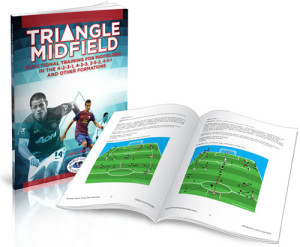The two most popular systems of play in the world at the moment are the 4-3-3 and the 4-2-3-1. Both are predicated on creating a connection between a group of three midfielders. Getting these players to understand their roles and work together are the key factors that will contribute to the success or failure of the team.
Our latest book, Triangle Midfield tells you everything you need to know about implementing a three man midfield effectively. It covers all the formations associated with a three man midfield in depth, explaining the functionality of the formation along with an extensive collection of drills and exercise for training your team to play with a three man midfield in possession and in defense.
The excerpt below focuses on training possession and penetration through the midfield.
The following represents examples of how to train for possession and/or penetration in a 1-4-3-3 Midfield with two attacking and one holding midfielder. There are a total of four (4) different exercises to accomplish what you need to in order to train or prepare your midfield to play this formation.
The examples used will be very similar to the ones used in prior formations to illustrate their similarities and differences. This is important so that you, as the coach, understand the actual differences in the formations and movements of the players using the same situations and examples. You will see that the training of possession and penetration is essentially the same. However, it is the differences in your own philosophy that will change the impact of every exercise.
Exercise #1 (Possession and Penetration- MF Combinations)
Frame #1- The exercise begins with the coach passing the ball to the holding midfielder. Make sure to watch the adjustments of the triangle midfield to make sure they are in position and adjusting to the ball. You can see how the two attacking central midfielders are supporting forward at an angle to the ball. This opens up the main option of the central attacker (#9).
Frame #2- The holding midfielder receives the ball and turns with possession to face towards the goal. The two attacking central midfielders continue to support at an angle, but as a continuation, the holding midfielder passes the ball forward to the central attacker. The arrows in the diagram show the supporting runs each of the triangle midfielders would then make. The weak side attacking central midfielder would look to make a penetrating run forward, the ball side attacking central midfielder would tuck in behind the ball to give direct support, and the holding central midfielder would shift slightly to their right to maintain the shape of the triangle while also being in a position to protect the middle of the field.
This is the basic setup for this exercise. The next two frames will show you just one pattern that can be run with this. However, there are dozens of different patterns you can run from this basic setup. In addition, begin the exercise with no defenders and work on locating your passes, the movement of the triangle midfielder and other players in the system, and the consistency of play. If you would like to see other examples of different midfield combinations, then please look at another World Class Coaching book, ‘Dutch Drills for Total Team Training’.
The rest of this session and many others are included in Triangle Midfield and the companion eBook, Training The Triangle Midfield.
[wpsharely id="6889"][/wpsharely]Do you have a drill or exercise that has helped you train players to work together in a triangle midfield? Please post your ideas in the comments section below.
Have a Great Day!
Tom



